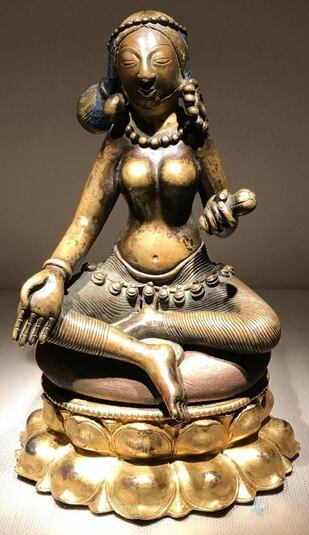
Item: Tara (Buddhist Deity)
| Origin Location | Tibet |
|---|---|
| Lineages | Buddhist |
| Material | Metal |
| Collection | Private |
Classification: Deity
Tara, Goddess of Activity attributed to the artist Choying Dorje (1604-1674), his atelier, or the work of a later artist copying the style.
Tara has one face and two hands, the right in a gesture of generosity extended across the knee and the left hand holding a flower blossom in a casual gesture. The legs are folded in front in a relaxed posture. She has a simple bead string for a headress, two mis-matched earrings, a necklace, bracelets and a string of bells around the waist. It is fair to say that this depiction of the deity Tara is non-iconic. It does not follow any strict iconographic descriptions as written in the ritual and meditational texts.
There are at least six sculpture, all female figures, in this style all attributed to the artist Choying Dorje or his atelier, or to later copies. It has not yet been adequately proven if all or any of these works were actually produced by Choying Dorje himself. None of the known sculpture have any inscriptions or identifying marks. Is it possible that one or more of these sculpture, or another sculpture, is the earlier source for the inspiration to copy or duplicate such a work and predates Choying Dorje?
Although Tara is the most common iconographic identification applied to these sculpture, alternately the goddess of learning and poetry Sarasvati has been suggested by some scholars. Tara is often the first choice for identification based on Choying Dorje’s preference of Lokeshvara and Tara as his special meitational deities. The solitary attribute that helps suggest it might be the goddess Tara is the single short stemmed flower blossom held in the upraised left hand. The flower appears to be a bud, possibly a lotus, unopened, or it could be an utpala bud or flower. The iconography of Green Tara is associated with the utpala flower, the night lotus, blue in colour. White Tara with very fixed and precise iconography holds a white utpala in the left hand with a long stem held at the heart.
At first glance, the sculpture appears very naive, unbalanced, and possibly the work of an untrained artist. However, the simple ornamentation and the hair tied in a bun and hanging to the side of the head is deliberate. The two mis-matched earrings, one much larger than the other, harken back a millenium to Pala and Nepalese style Pala art. The striations of the lower garment hint of the Swat Valley and Kashmiri style. Lastly, the string of bells at the waist is thoughtful and done with purpose, regardless of the artists training or skill.
(The cushion beneath the legs and the double lotus base, inscribed with ‘tashi lima,’ are newly acquired and not original to the sculptural figure).
Jeff Watt 6-2018
Collection of Zhiguan Museum of Fine Art
Collection of Zhiguan (Sculpture)
Collection of Zhiguan (Choying Dorje Atelier)
Artist: Choying Dorje & Atelier (Sculpture)
Buddhist Deity: Tara, Green Main Page
Buddhist Deity: Tara (sculpture)
Sculpture: Tara Comparison (Choying Dorje Atelier)
